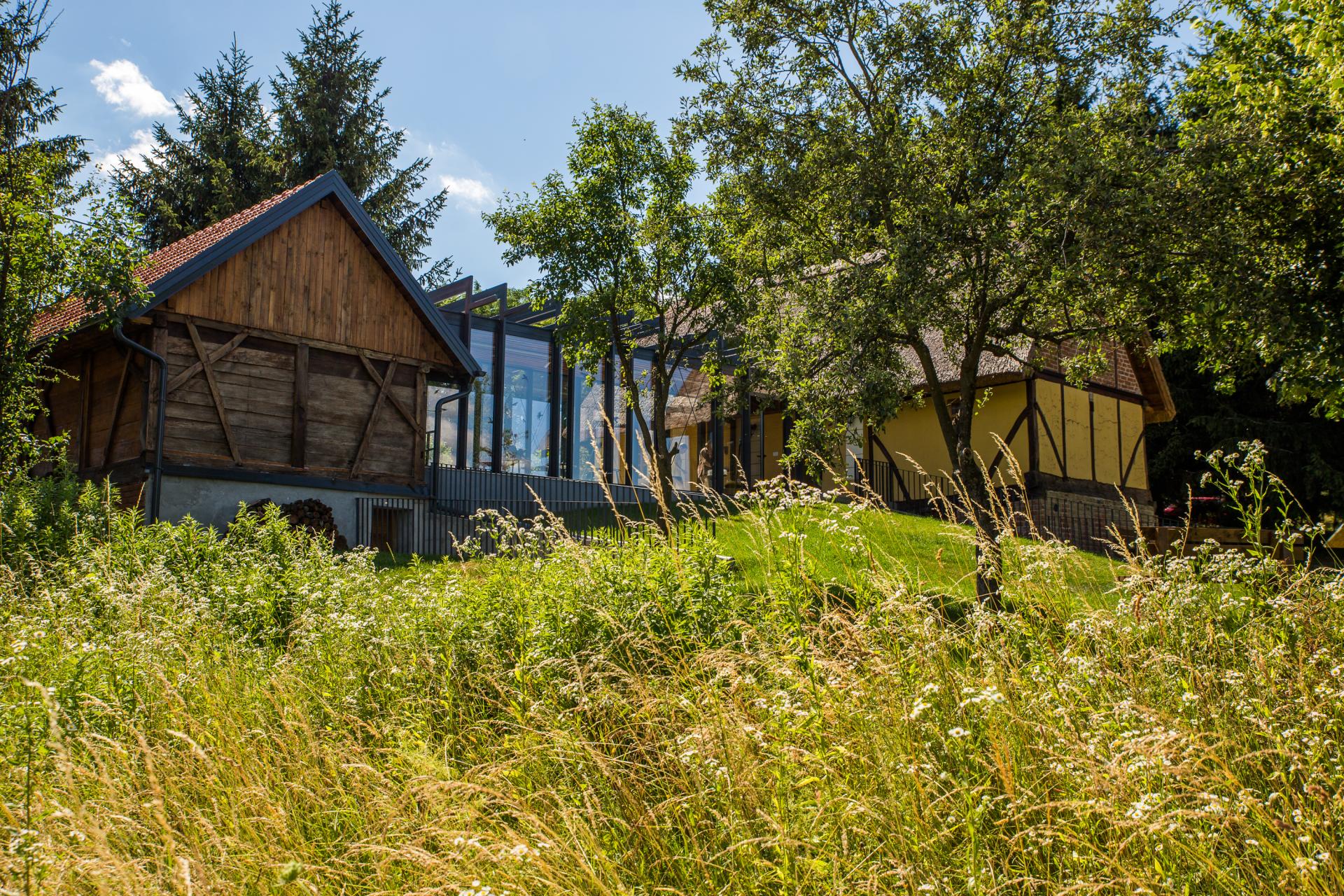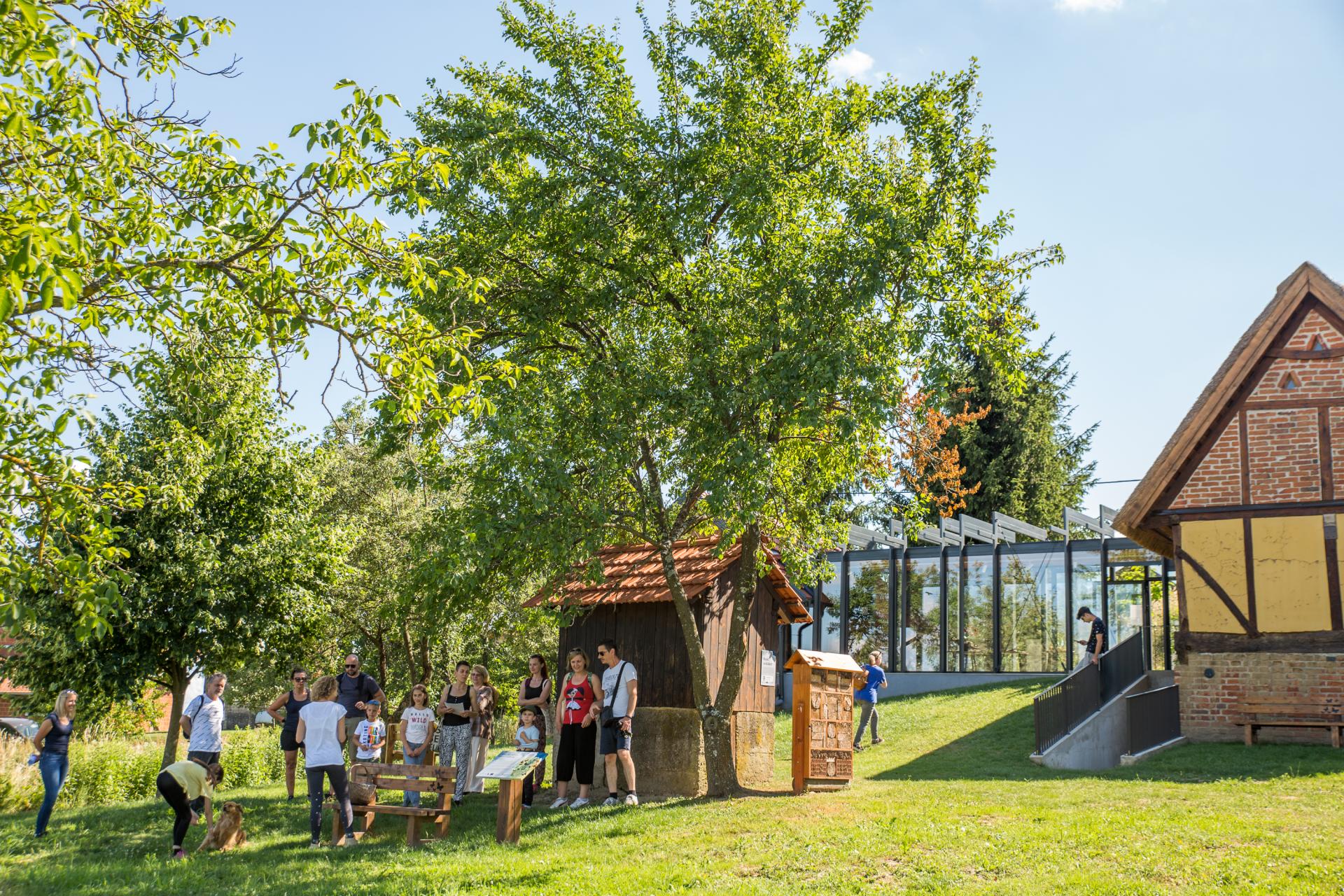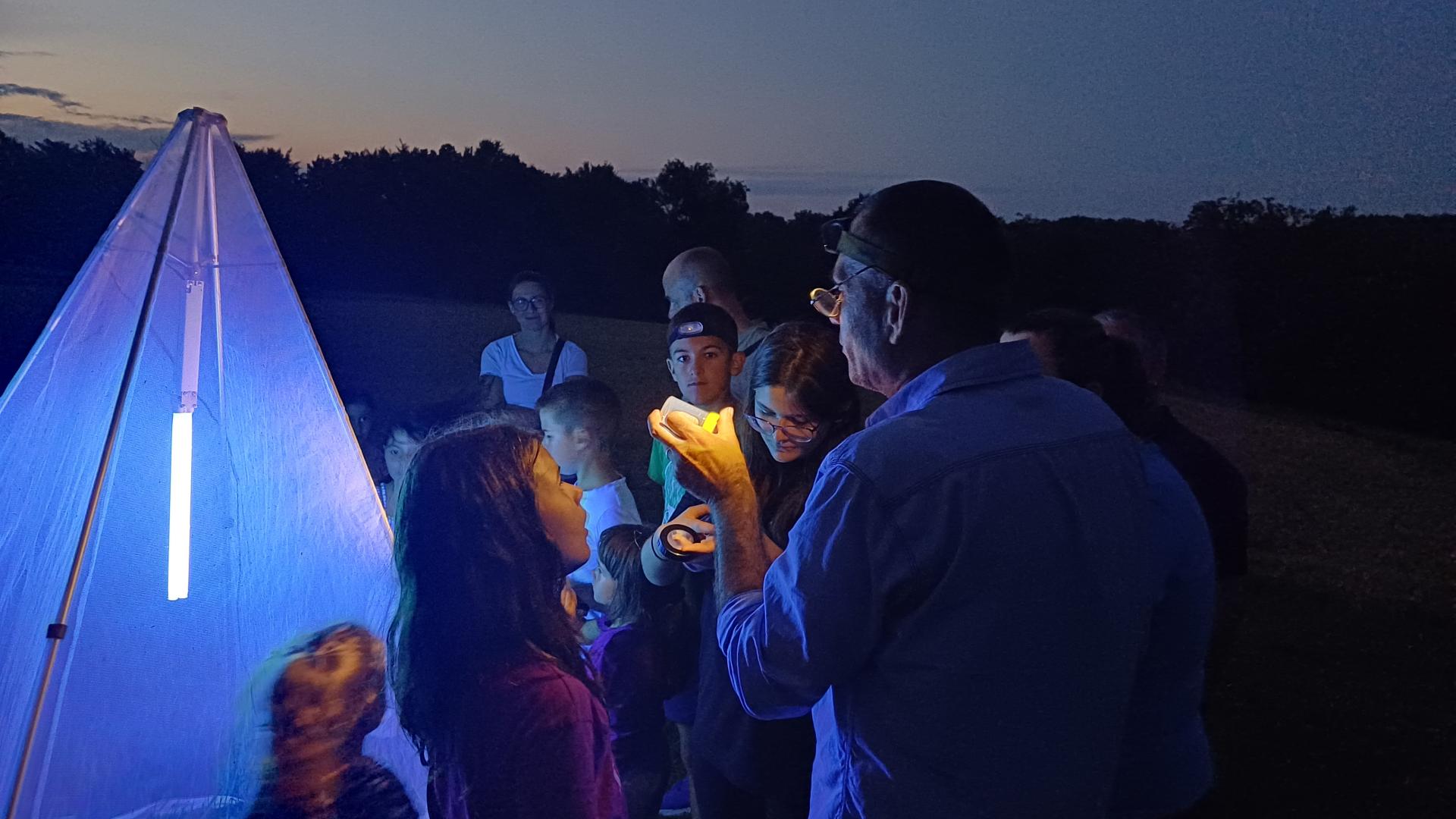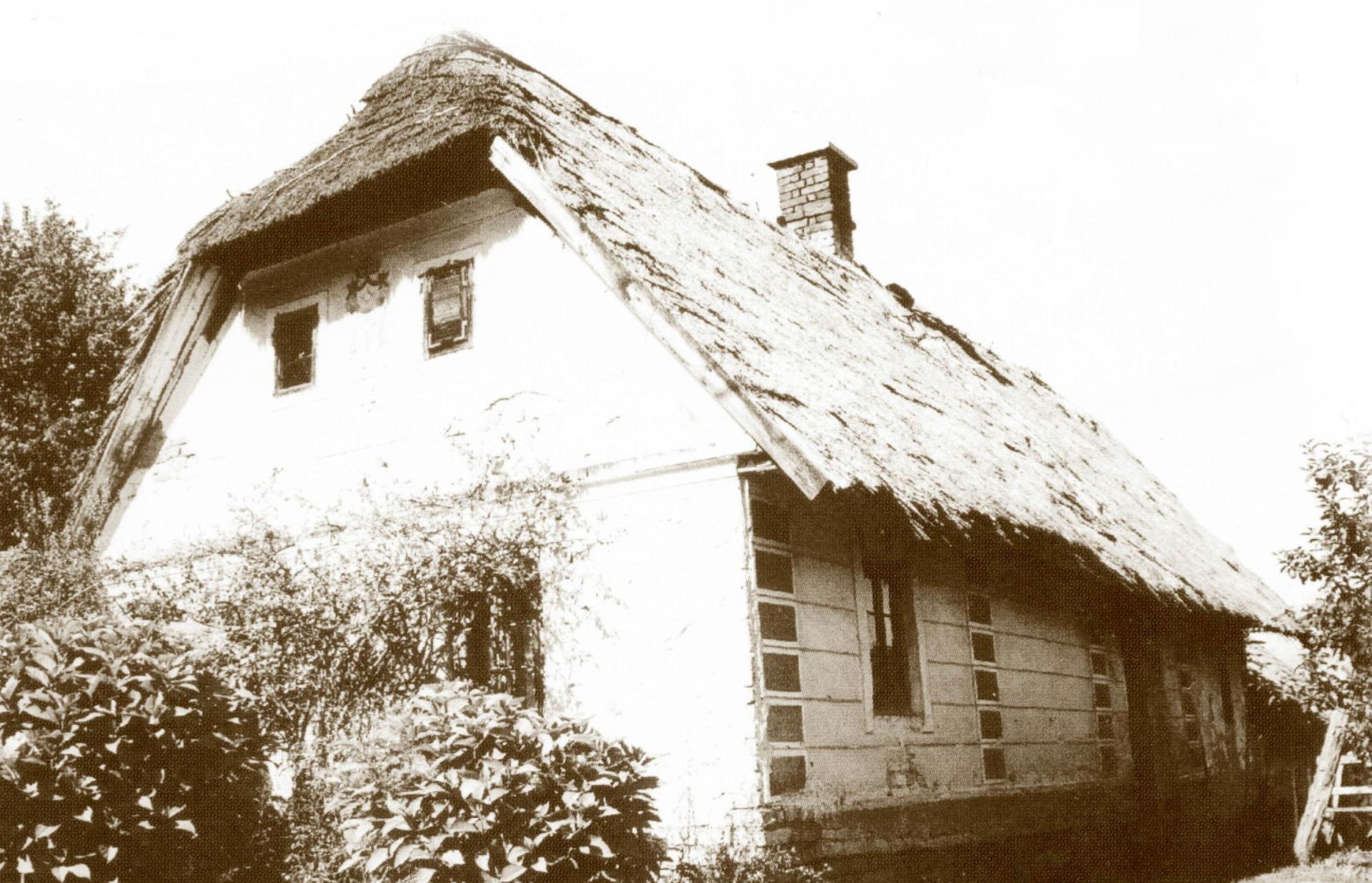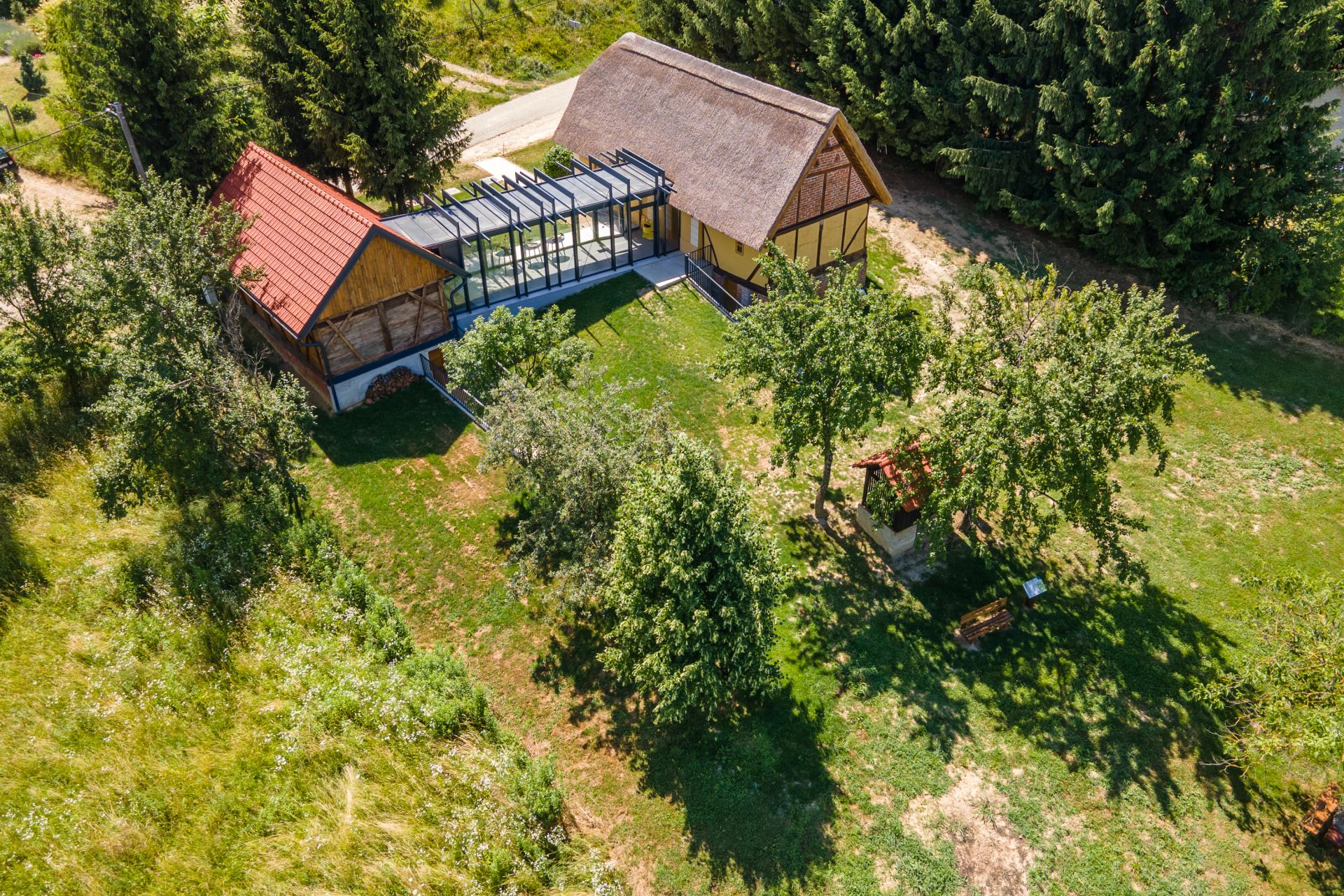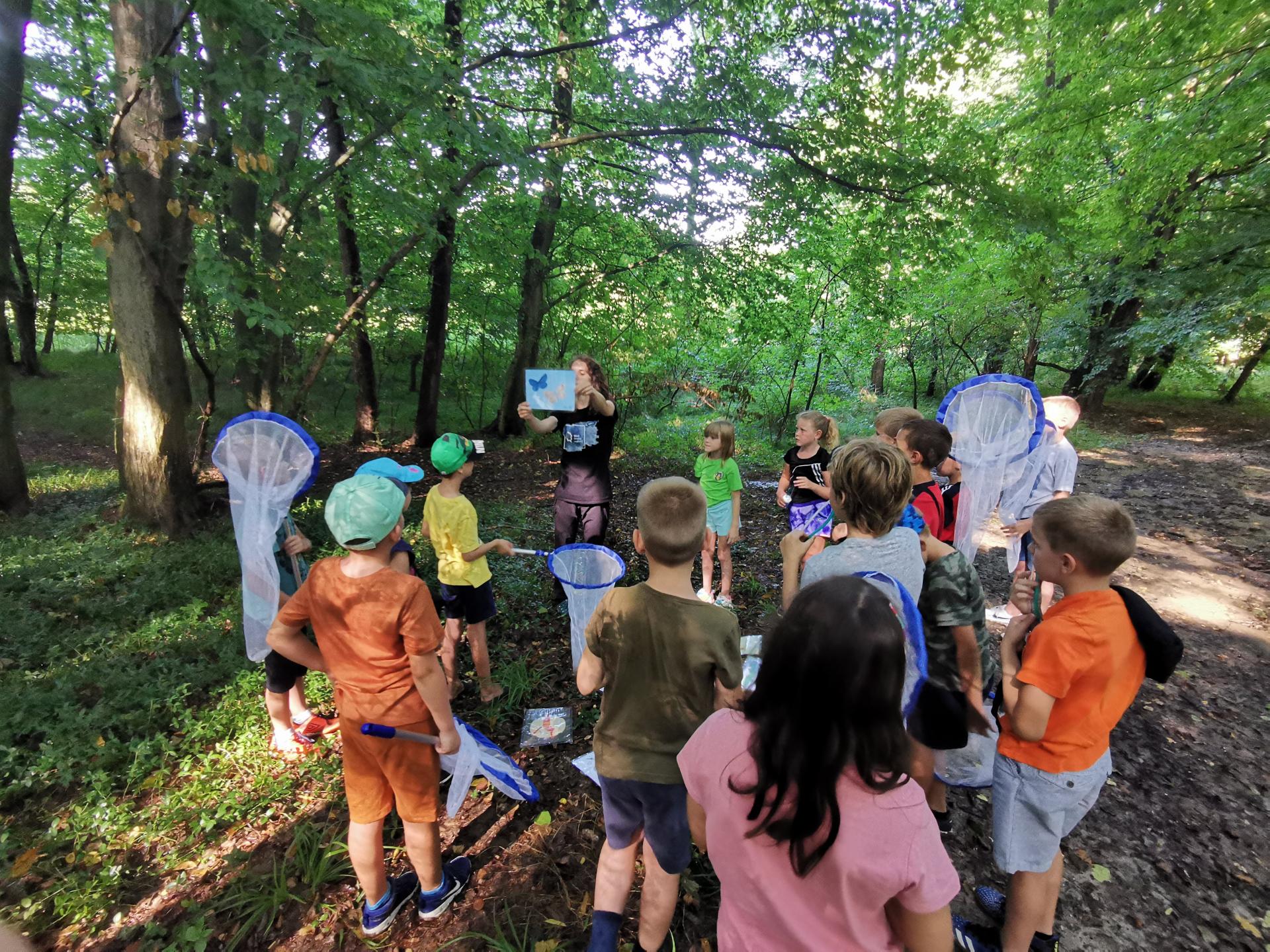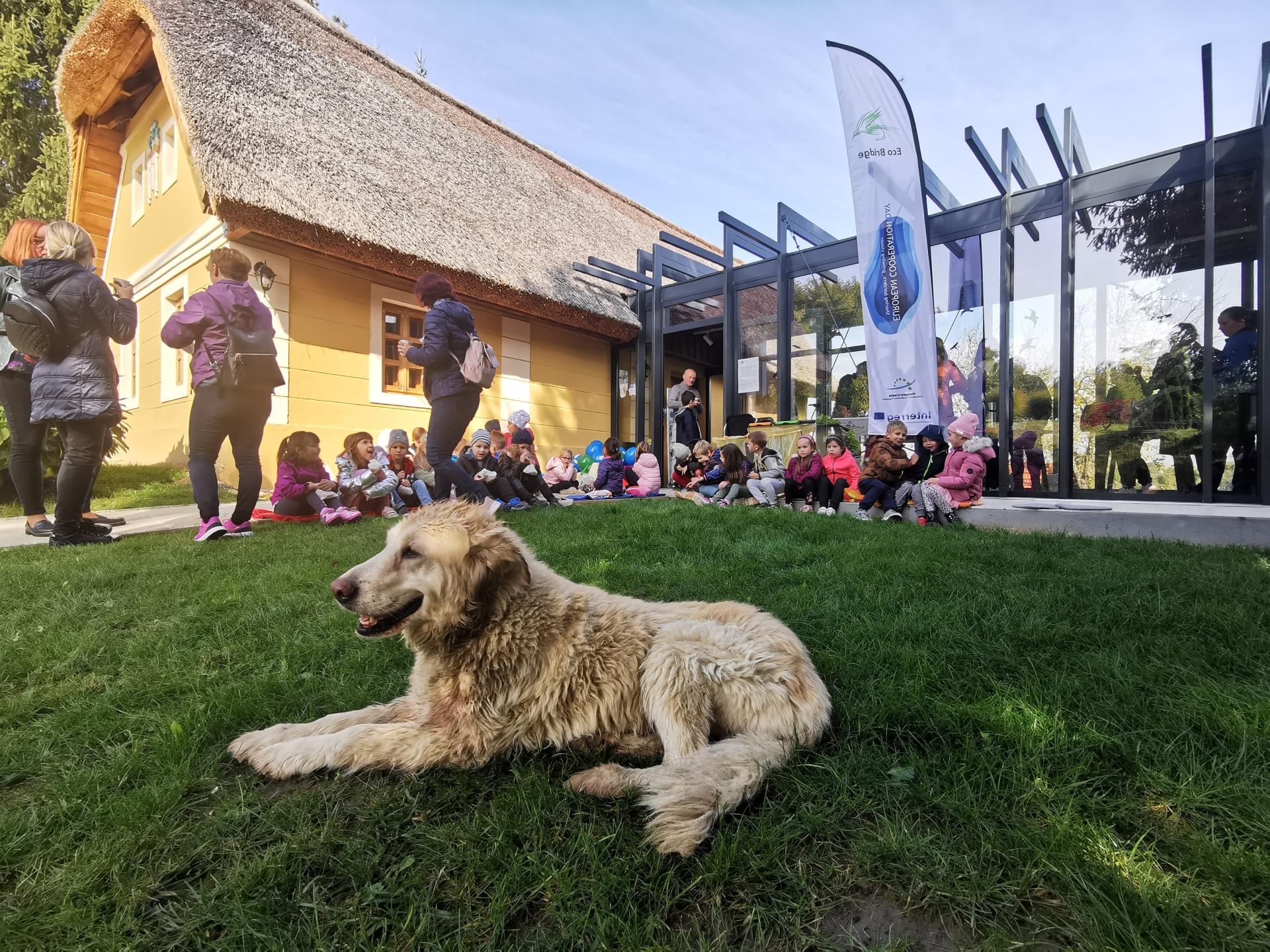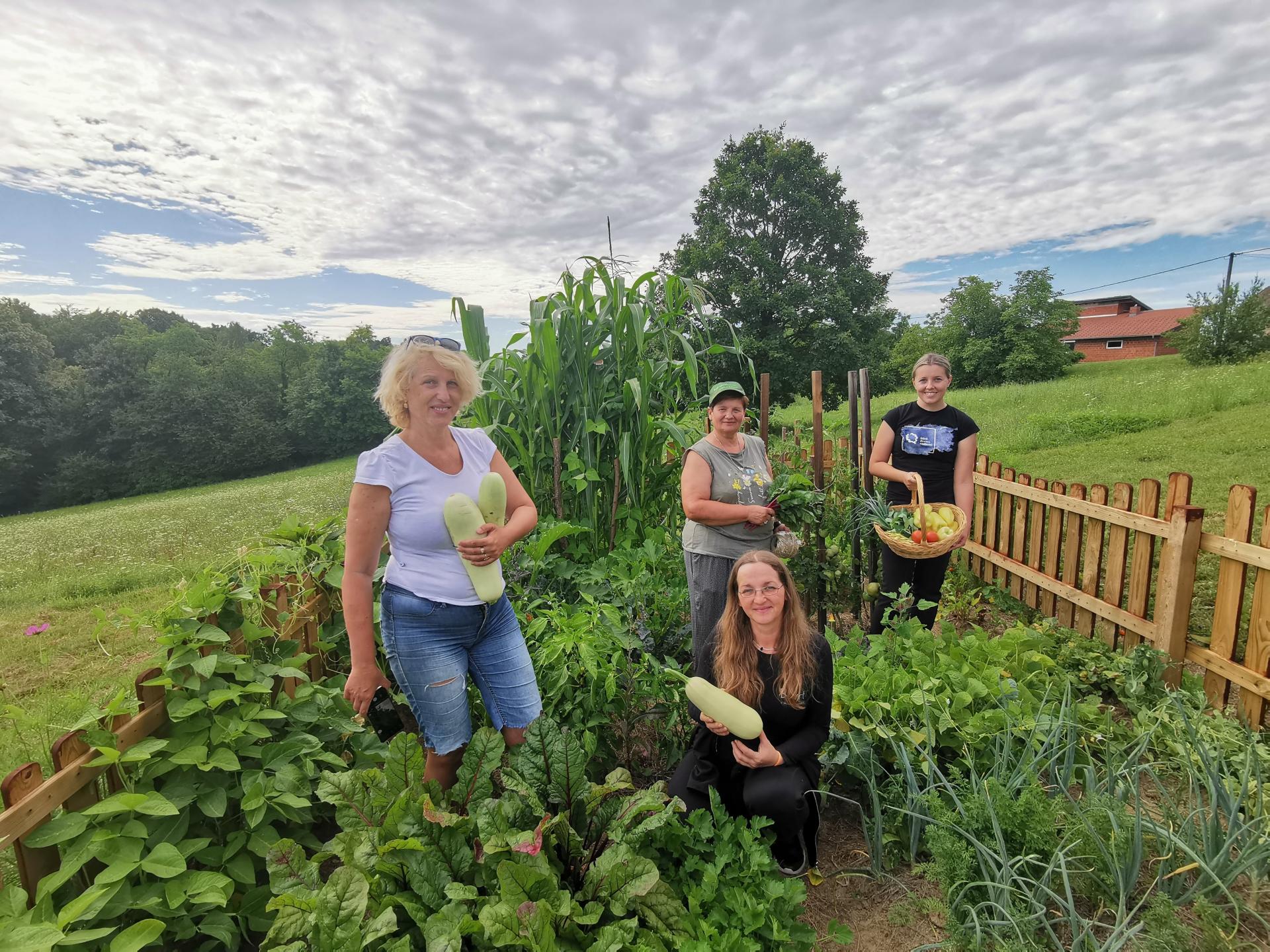Matul's grunt
Basic information
Project Title
Matul's grunt
Full project title
Educational and research centre Frkanovec
Category
Reconnecting with nature
Project Description
Matul's grunt is a rural architectural heritage property and represents the first educational research centre in Croatia dedicated to blue butterflies. It contains a space for creative work and a permanent exhibition about the meadows and butterflies and is located in the area of the Natura 2000 ecological network. Today this is a place of unique experience where visitors are encouraged to rethink their attitudes towards nature and awake memories of some long-forgotten customs.
Geographical Scope
Regional
Project Region
Medjimurje county, Croatia, Croatia
Urban or rural issues
Mainly rural
Physical or other transformations
It refers to a physical transformation of the built environment (hard investment)
EU Programme or fund
Yes
Which funds
ERDF : European Regional Development Fund
Description of the project
Summary
The old house (hiza) in Frkanovec was built more than a hundred years ago in the spirit of the tradition of the Medjimurje County in Croatia. It is a well-preserved example of rural architecture and with the reconstruction and conversion of the house, the associated farm building and land, an educational and research centre was created, dedicated to butterflies and significant habitats of plant and animal species of the upper Medjimurje. In the Kajkavian dialect, the word “matul” is used for the word butterfly, and the word “grunt” for a property. Therefore, in the spirit of Medjimurje Kajkavian, the centre was called Matul’s grunt. It is located in the area of Natura 2000 ecological network, not far from the Bedekoviceva graba site. Matul’s grunt contains a permanent art exhibition about the meadows and butterflies of upper Medjimurje, as well as a space for workshops. The old house in Frkanovec is also a place of residence for naturalists, researchers and artists but most importantly, a place where local residents, especially young people and occasional passers-by can visit the house for free and enjoy in multiple programs, feel the connection with nature, see our special blue butterfly and remember the former way of coexistence between man and nature, without the buzzing of mobile phones and machines, but really connect mind and body with the nature around them.
Matul’s grunt was created as part of the broader project "Between Two Waters" funded from ERDF with the objective of increasing awareness of nature heritage importance though improved visitor infrastructure of Medjimurje County. This project can be considered to be in line with the moto BEAUTIFUL SUSTAINABLE TOGETHER. Whoever experiences the charms of Matul's grunt once again wants to return to the shelter of its peace, comfort and homely "touch". The village of Frkanovec is becoming an increasingly recognizable place for writers, researchers and naturalists in Croatia and beyond.
Matul’s grunt was created as part of the broader project "Between Two Waters" funded from ERDF with the objective of increasing awareness of nature heritage importance though improved visitor infrastructure of Medjimurje County. This project can be considered to be in line with the moto BEAUTIFUL SUSTAINABLE TOGETHER. Whoever experiences the charms of Matul's grunt once again wants to return to the shelter of its peace, comfort and homely "touch". The village of Frkanovec is becoming an increasingly recognizable place for writers, researchers and naturalists in Croatia and beyond.
Key objectives for sustainability
Matul's grunt was created as part of the larger project "Between Two Waters", the goal of which was to improve the visitor infrastructure and strengthen the visitor management system of the Mura-Drava Regional Park in Medjimurje County in order to increase the attractiveness and educational character of natural heritage sites. In addition to infrastructure, the goal of the project was to increase the knowledge and awareness of the local population and visitors about the peculiarities of the natural heritage in the area and the importance of preserving its biodiversity, as well as promoting the natural heritage of the Mura-Drava Regional Park and the ecological network in the area of Medjimurje County in order to increase attractiveness of the area, but at the same time assuring sustainability of natural heritage and the environment in general.
With the completion of the project, Matul's grunt became a new "old" attraction, but great in its uniqueness and charm. Namely, the house and property itself evoke some ancient times, the coexistence of man and nature as nurtured by people 100 years ago and which is actually an attraction and something unprecedented for today's generations. Natural and sustainable materials were used as much as possible. The roof was reconstructed and supplemented with new straw in order to preserve its original shape, and also part of the walls, which are made of mud. Precisely for the reason that it is necessary to maintain, preserve, protect and educate people, especially the young, about the importance of biodiversity and about traditional values that must not be forgotten, this is precisely the value in which the sustainability of Matul's grunt is secured.
With the completion of the project, Matul's grunt became a new "old" attraction, but great in its uniqueness and charm. Namely, the house and property itself evoke some ancient times, the coexistence of man and nature as nurtured by people 100 years ago and which is actually an attraction and something unprecedented for today's generations. Natural and sustainable materials were used as much as possible. The roof was reconstructed and supplemented with new straw in order to preserve its original shape, and also part of the walls, which are made of mud. Precisely for the reason that it is necessary to maintain, preserve, protect and educate people, especially the young, about the importance of biodiversity and about traditional values that must not be forgotten, this is precisely the value in which the sustainability of Matul's grunt is secured.
Key objectives for aesthetics and quality
In the last 2 years, more than 20 writers/poets/bloggers/travel writers/essayists/literary critics, one opera singer, and numerous naturalists who came individually or in groups as members of associations organized a series of interesting events for the local population and all interested visitors. The idea of Matul's grunt is not for it to be just a static house and property, but to live in harmony with its visitors, providing them a place for education and unique experience, encouraging them to rethink their attitudes towards nature, awakening memories of some long-forgotten customs, even taking them back to their childhood when most of the people in Medjimurje from an early age were happy to help their grandparents in the fields and when hanging out in the meadows were the most beautiful memories.
Regarding the aesthetics, the property built about 100 years ago in a traditional manner, with its harmoniously balanced dimensions, characteristic spatial organization and details in the interior, represents one of the rarely preserved original examples of a historical setting of undoubted cultural, monumental and ethnographic value. Respecting the historical and architectural heritage, in order to meet modern functional needs, the house and property were reconstructed with the aim to make Matul's grunt the first educational research centre in Croatia dedicated to blue butterflies and the first artistic and scientific residence in Medjimurje County. Through a digital presentation visitors can explore the lifecycle of butterflies and other important pollinators.
Regarding the aesthetics, the property built about 100 years ago in a traditional manner, with its harmoniously balanced dimensions, characteristic spatial organization and details in the interior, represents one of the rarely preserved original examples of a historical setting of undoubted cultural, monumental and ethnographic value. Respecting the historical and architectural heritage, in order to meet modern functional needs, the house and property were reconstructed with the aim to make Matul's grunt the first educational research centre in Croatia dedicated to blue butterflies and the first artistic and scientific residence in Medjimurje County. Through a digital presentation visitors can explore the lifecycle of butterflies and other important pollinators.
Key objectives for inclusion
The project was designed to be inclusive in terms of accessibility and affordability. This is why, however challenging it was, the ground floor of the old house, the property around the house and the associated farm building were all reconstructed in order to meet the goal of accessibility to persons with mobility impairments. Furthermore, the site and the exhibition are also accessible for persons with visual impairment with specially adapted audio description. The accompanying website is in line with the principle of universal design. The very fact that the site is located in the area of the Natura 2000 ecological network, not far from the site of Bedeković's Graba where the existence of as many as 81 plant species and 63 species of butterflies was recorded, directed the purpose of Matul's grunt towards interpretation dedicated to blue butterflies and significant habitats of plant for all people, given the fact that many natural heritage locations are not accessible for persons with disabilities. Here, everyone is invited to join multiple programs, as an individual or visit in a group.
The programs are organized in warmer part of the year and visiting the house is free of charge and all the programs and camps are based on voluntary work, thereby engaging the local community. While the house itself is open only for announced visits, the outdoor property surrounding the house is available to the local population or occasional visitors throughout the year because it is equipped with educational boards about the natural heritage of upper Medjimurje and there is a space for rest and contemplation in nature at any time of the day.
The programs are organized in warmer part of the year and visiting the house is free of charge and all the programs and camps are based on voluntary work, thereby engaging the local community. While the house itself is open only for announced visits, the outdoor property surrounding the house is available to the local population or occasional visitors throughout the year because it is equipped with educational boards about the natural heritage of upper Medjimurje and there is a space for rest and contemplation in nature at any time of the day.
Results in relation to category
The most important result is the involvement of the local community and experts in nature in the common goal of preserving biodiversity, especially the blue butterfly, in the area of Medjimurje. Matul’s grunt has become an example of investment of EU funds in sustainable solutions, reconstruction and conversion of existing traditional properties using sustainable materials and as a space for employment of new experts in nature and a place for monitoring the ecosystem.
By reconstructing this old property, we did not disturb the natural balance, did not encourage excessive construction, and did not have a negative impact on climate change. Through constructive thinking, we have achieved the following benefits for directs and indirect beneficiaries: the house and its auxiliary building are energy efficient, given that we used sustainable materials during the reconstruction; the environment was remodelled in accordance with the natural ecosystem that is specific to the Medjimurje area; we respected the aesthetics of the house and only added the necessary modern elements (sanitary node, etc.); the site is accessible for persons with disabilities; throughout the renovation we respected the opinions of experts in nature, artists, designers, architects, citizens and other creative people from different disciplines, and later included the same people in the development of programs for the community and tourists.
It is also important to point out that the "Between two waters" project in 2022 won 2nd place in the Best EU Project competition organized by the Croatian Union of Counties and the Office of the European Parliament in Croatia, and that the main visitor centre in Krizovec won the prestigious BigSEE Tourism Design Award in 2021 https://bitly.ws/ZdGd
By reconstructing this old property, we did not disturb the natural balance, did not encourage excessive construction, and did not have a negative impact on climate change. Through constructive thinking, we have achieved the following benefits for directs and indirect beneficiaries: the house and its auxiliary building are energy efficient, given that we used sustainable materials during the reconstruction; the environment was remodelled in accordance with the natural ecosystem that is specific to the Medjimurje area; we respected the aesthetics of the house and only added the necessary modern elements (sanitary node, etc.); the site is accessible for persons with disabilities; throughout the renovation we respected the opinions of experts in nature, artists, designers, architects, citizens and other creative people from different disciplines, and later included the same people in the development of programs for the community and tourists.
It is also important to point out that the "Between two waters" project in 2022 won 2nd place in the Best EU Project competition organized by the Croatian Union of Counties and the Office of the European Parliament in Croatia, and that the main visitor centre in Krizovec won the prestigious BigSEE Tourism Design Award in 2021 https://bitly.ws/ZdGd
How Citizens benefit
This property is not created by today's generation; today’s generation just gave it a new name and a new purpose. Like every property, this one has its own story. “Grunt” was discovered and recognized as significant at the turn of the 20th and 21st centuries, when heritage worthy of preservation for new generations was listed throughout Medjimurje. It was a time of reflection and a new appreciation of native values. Just at that time, the Natural Monument of Bedekovic's graba was declared Natura 2000 site (December 2002). Soon after that, the property was purchased by the regional government Medjimurje County and they slowly prepared it for its current purpose through various activities and projects where different NGOs and educational institutions were involved. In its current form, Matul's grunt was officially opened in March 2021.
All volunteers who have taken care of the land for the past 20 years, all local residents and members of nature protection associations who contributed to the design of numerous programs that raised awareness of the importance of preserving this valuable location and its meaning were informed about the project during preparation and implementation and were invited to the opening ceremony.
The dialog and cooperation are maintained further on. So today, Matul's grunt is a residence for artists, writers and nature scientists, and together with local people and various associations, programs for visitors are designed, such as lectures on biodiversity, camps for young nature conservationists, workshops on the importance of meadows, trees and forests, open days, organized night butterfly watching etc. There is also an organic garden on the property, where workshops on organic gardening are held in cooperation with local organic agricultural producers and it is used to grow food for the residents who stay there.
All volunteers who have taken care of the land for the past 20 years, all local residents and members of nature protection associations who contributed to the design of numerous programs that raised awareness of the importance of preserving this valuable location and its meaning were informed about the project during preparation and implementation and were invited to the opening ceremony.
The dialog and cooperation are maintained further on. So today, Matul's grunt is a residence for artists, writers and nature scientists, and together with local people and various associations, programs for visitors are designed, such as lectures on biodiversity, camps for young nature conservationists, workshops on the importance of meadows, trees and forests, open days, organized night butterfly watching etc. There is also an organic garden on the property, where workshops on organic gardening are held in cooperation with local organic agricultural producers and it is used to grow food for the residents who stay there.
Physical or other transformations
It refers to a physical transformation of the built environment (hard investment)
Innovative character
The innovative character of the project is represented by the affordable programs for the general public that are distinguished by the fact that older generations come here to remember their childhood and growing up in the countryside while new generations find here the source of their native identity and a break from the urban bustle.
Regarding the location itself, the innovative aspect was applied during the reconstruction of the property, i.e. its architectural design. "Medjimurska hiza" is the architectural heritage of rural settlements in the northernmost area of Croatia, with a thatched roof, foundations of compacted clay soil, wooden structure, plastered with loam mixed with cereal chaff, the ceiling supported on load-bearing beams, etc. Through the process of modern architectural remodelling, a sanitary node was installed in the cottage, and the attic was arranged as a place for artists and researchers to stay. The glass cube was added as a modern interpretation of the “brajde” (poles with a structure on which the vines climb) that once stood between the house itself and the wooden storage room that houses the vintage grape press from the year 1840. The cube is a functional connection between two buildings and a space for receiving visitors.
In order to demonstrate living in harmony with nature, offering experience in an innovative way, the exterior of the property is carefully arranged and cared for; ancient varieties of fruit trees, a well, a bio garden in harmony with nature, meadows without invasive species and a gazebo as a space for socializing in an inspiring environment. Special attention is paid to the depiction of man and his traditional activities of annual mowing of meadows, which is crucial for preserving the habitat in conditions favourable for the survival of butterflies.
Regarding the location itself, the innovative aspect was applied during the reconstruction of the property, i.e. its architectural design. "Medjimurska hiza" is the architectural heritage of rural settlements in the northernmost area of Croatia, with a thatched roof, foundations of compacted clay soil, wooden structure, plastered with loam mixed with cereal chaff, the ceiling supported on load-bearing beams, etc. Through the process of modern architectural remodelling, a sanitary node was installed in the cottage, and the attic was arranged as a place for artists and researchers to stay. The glass cube was added as a modern interpretation of the “brajde” (poles with a structure on which the vines climb) that once stood between the house itself and the wooden storage room that houses the vintage grape press from the year 1840. The cube is a functional connection between two buildings and a space for receiving visitors.
In order to demonstrate living in harmony with nature, offering experience in an innovative way, the exterior of the property is carefully arranged and cared for; ancient varieties of fruit trees, a well, a bio garden in harmony with nature, meadows without invasive species and a gazebo as a space for socializing in an inspiring environment. Special attention is paid to the depiction of man and his traditional activities of annual mowing of meadows, which is crucial for preserving the habitat in conditions favourable for the survival of butterflies.
Disciplines/knowledge reflected
The project team consisted of:
- Institution Medjimurje Nature - experts in the field of nature protection and conservation, who provided inputs for the contents that will be included in the visitor centre programs, inputs on natural heritage for the project application
- Public Institution for the development of Medjimurje County REDEA – experts who prepared the project application for the ERDF competition and coordinated the entire team
- regional government Medjimurje County - who were in charge of coordinating the design of Matul's grunt with the architects
- Tourist board of Medjimurje County - who provided input regarding promotional activities and included the new site in the existing tourism products
- architects company A2Z Ltd. who designed Matul's grunt and later supervised the works
- the company Vlasic DN Usluge Ltd. who were in charge of the construction work
The project budget was approximately 1,9 million euros, and it started in July 2018 and was finished in March 2021. The budget for Matul’s grunt was approximately 260.000,00 eur. In the implementation of the project, it’s important to highlight the role of experts in the field of nature protection from institution Medjimurje Nature, who were in charge of designing educational and volunteering programs in the field of natural heritage and are responsible for managing the centre from its opening onwards. All mentioned knowledge fields were important to design and implement the project as well as to maintain the outcomes and results, which is the most important added value of the whole process. Thanks to the commitment of all involved Matul’s grunt is completing its purpose and contributing to the reputation of Medjimurje as a green destination.
- Institution Medjimurje Nature - experts in the field of nature protection and conservation, who provided inputs for the contents that will be included in the visitor centre programs, inputs on natural heritage for the project application
- Public Institution for the development of Medjimurje County REDEA – experts who prepared the project application for the ERDF competition and coordinated the entire team
- regional government Medjimurje County - who were in charge of coordinating the design of Matul's grunt with the architects
- Tourist board of Medjimurje County - who provided input regarding promotional activities and included the new site in the existing tourism products
- architects company A2Z Ltd. who designed Matul's grunt and later supervised the works
- the company Vlasic DN Usluge Ltd. who were in charge of the construction work
The project budget was approximately 1,9 million euros, and it started in July 2018 and was finished in March 2021. The budget for Matul’s grunt was approximately 260.000,00 eur. In the implementation of the project, it’s important to highlight the role of experts in the field of nature protection from institution Medjimurje Nature, who were in charge of designing educational and volunteering programs in the field of natural heritage and are responsible for managing the centre from its opening onwards. All mentioned knowledge fields were important to design and implement the project as well as to maintain the outcomes and results, which is the most important added value of the whole process. Thanks to the commitment of all involved Matul’s grunt is completing its purpose and contributing to the reputation of Medjimurje as a green destination.
Methodology used
Preservation of cultural and natural heritage is part of the strategic orientation of Medjimurje County.When designing the broader project,it was decided that Matul's grunt, located centrally within the area of the ecological network,would be dedicated to research focused on nature, complementing the offer of the main interpretation centre in Križovec.The exhibits and educational research programs are available for free by appointment and during regular open days, but the property surrounding the house itself equipped with information boards for self-education is accessible throughout the year.
While developing the concept of the space,we took into account the availability of content, sustainability, preservation of traditional construction,expediency,economy, and proper inclusion of target groups. The restoration of the house required a careful approach due to its age and uniqueness,such as the fact that it had an old thatched roof, an old large press in a post-war auxiliary building and walls made of a combination of soil,water and straw. Today, the house is continuously used, mostly through residences,which is an innovative approach in Medjimurje County,assuring a place to create and work in a peaceful and inspiring environment.
Financial maintenance of the building is handled by Medjimurje County,while the management is given to the Medjimurje Nature and they interact with the local community to examine opinions about the quality of the program and collect ideas for improving existing and designing new activities.
All this led to the fact that today Matul's grunt is often mentioned in professional literature and visited by experts in the field of nature protection, and the project partners use the knowledge gained from the "Between two waters" project in designing new actions.Also,the house is interesting to architects and historians because of its architectural and historical heritage as well are the sustainable materials used during the renovation.
While developing the concept of the space,we took into account the availability of content, sustainability, preservation of traditional construction,expediency,economy, and proper inclusion of target groups. The restoration of the house required a careful approach due to its age and uniqueness,such as the fact that it had an old thatched roof, an old large press in a post-war auxiliary building and walls made of a combination of soil,water and straw. Today, the house is continuously used, mostly through residences,which is an innovative approach in Medjimurje County,assuring a place to create and work in a peaceful and inspiring environment.
Financial maintenance of the building is handled by Medjimurje County,while the management is given to the Medjimurje Nature and they interact with the local community to examine opinions about the quality of the program and collect ideas for improving existing and designing new activities.
All this led to the fact that today Matul's grunt is often mentioned in professional literature and visited by experts in the field of nature protection, and the project partners use the knowledge gained from the "Between two waters" project in designing new actions.Also,the house is interesting to architects and historians because of its architectural and historical heritage as well are the sustainable materials used during the renovation.
How stakeholders are engaged
Partners from several regional/local organizations were involved in the implementation of the "Between two waters" project:
- Experts from institution Medjimurje Nature were responsible for the establishment of the "Med dvemi vodami" visitor centres,for the design of interpretation methods,the education of local population about the importance of preserving natural heritage,the education of tourist guides for natural heritage and the creation of an Action Plan for visitor management.
- Experts from the Public Institution REDEA were in charge of the implementation of the entire project coordination of works on the Matul’s grunt and public procurement.
- Experts from Medjimurje County were in charge of supervising works on the Matul’s grunt and public procurement.
- the municipality of Sveti Juraj na Bregu where Frkanovec is situated gave their support and are included in the promotion of the area
- Experts from the Tourist Board of Medjimurje County were in charge of promoting the new attractions.
The project received support from the Ministry of Regional Development and EU funds of the Republic of Croatia in the form of co-financing and during the entire implementation period experts from the field of natural sciences provided support to experts from Medjimurje Nature.
We must also emphasize the importance of the local population, especially children, who were happy to participate in educational programs and are now volunteering in nature preservation programs at various locations in Medjimurje(rescuing amphibians from suffering on the roads,cleaning the coast for sandpipers,counting nests of swallows and terns,tracking deers,bird recognition training).
Local architects and builders were involved in the design of the centre and the supervision of works.
We can say that optimal results were achieved through this symbiosis of all stakeholders,and the cooperation of all the above continued even after the end of the project.
- Experts from institution Medjimurje Nature were responsible for the establishment of the "Med dvemi vodami" visitor centres,for the design of interpretation methods,the education of local population about the importance of preserving natural heritage,the education of tourist guides for natural heritage and the creation of an Action Plan for visitor management.
- Experts from the Public Institution REDEA were in charge of the implementation of the entire project coordination of works on the Matul’s grunt and public procurement.
- Experts from Medjimurje County were in charge of supervising works on the Matul’s grunt and public procurement.
- the municipality of Sveti Juraj na Bregu where Frkanovec is situated gave their support and are included in the promotion of the area
- Experts from the Tourist Board of Medjimurje County were in charge of promoting the new attractions.
The project received support from the Ministry of Regional Development and EU funds of the Republic of Croatia in the form of co-financing and during the entire implementation period experts from the field of natural sciences provided support to experts from Medjimurje Nature.
We must also emphasize the importance of the local population, especially children, who were happy to participate in educational programs and are now volunteering in nature preservation programs at various locations in Medjimurje(rescuing amphibians from suffering on the roads,cleaning the coast for sandpipers,counting nests of swallows and terns,tracking deers,bird recognition training).
Local architects and builders were involved in the design of the centre and the supervision of works.
We can say that optimal results were achieved through this symbiosis of all stakeholders,and the cooperation of all the above continued even after the end of the project.
Global challenges
Community empowerment/Climate change – UN SDG 13
All the programs that are organized today at Matul's grunt are the work of volunteers. Encouraging volunteering in the area of natural heritage contributes to the development of fundamental values such as the protection of nature and the environment, solidarity, tolerance and togetherness, and at the same time people can enjoy natural beauty and socialize with each other, consequently adjusting their attitudes about the role of individuals in mitigating and adaptation to climate change.
Cultural/Natural heritage – UN SDG 11.4.
Matul's grunt is an interesting attraction for today's generations, but there are those a little older who still remember how people used to live and work in Medjimurje. We are proud that the memory of our tradition of coexistence of man and nature lives on through Matul's grunt, and that this native and natural heritage is visited by people from all over the world. Appreciation of local cultural and natural heritage contributes to the preservation of world’s heritage.
Ecosystems, biodiversity loss – UN SDG 15.5., 15.7., 15.9.,
Through programs for the community, experts from the field of nature protection convey important lessons and demonstrate methods and tools that are necessary for the preservation of biodiversity. Preservation of butterflies is just as important as preservation of bees. Butterflies are one of the most important pollinators, and the whole world that we know depends on pollinators. Although their suffering is less talked about, they too fall as victims of the mindless use of chemical agents in agriculture. Through the educational programs available at the location of Matul's grunt, we want to increase the local community's awareness of the importance of biodiversity because we believe that through education, we can change attitudes and behaviours and make a local contribution to solving global problems.
All the programs that are organized today at Matul's grunt are the work of volunteers. Encouraging volunteering in the area of natural heritage contributes to the development of fundamental values such as the protection of nature and the environment, solidarity, tolerance and togetherness, and at the same time people can enjoy natural beauty and socialize with each other, consequently adjusting their attitudes about the role of individuals in mitigating and adaptation to climate change.
Cultural/Natural heritage – UN SDG 11.4.
Matul's grunt is an interesting attraction for today's generations, but there are those a little older who still remember how people used to live and work in Medjimurje. We are proud that the memory of our tradition of coexistence of man and nature lives on through Matul's grunt, and that this native and natural heritage is visited by people from all over the world. Appreciation of local cultural and natural heritage contributes to the preservation of world’s heritage.
Ecosystems, biodiversity loss – UN SDG 15.5., 15.7., 15.9.,
Through programs for the community, experts from the field of nature protection convey important lessons and demonstrate methods and tools that are necessary for the preservation of biodiversity. Preservation of butterflies is just as important as preservation of bees. Butterflies are one of the most important pollinators, and the whole world that we know depends on pollinators. Although their suffering is less talked about, they too fall as victims of the mindless use of chemical agents in agriculture. Through the educational programs available at the location of Matul's grunt, we want to increase the local community's awareness of the importance of biodiversity because we believe that through education, we can change attitudes and behaviours and make a local contribution to solving global problems.
Learning transferred to other parties
A project like ours can easily be replicated in any region in Europe because each region has its own traditional depiction of life in the past and some kind of specific natural heritage. It is important for current and future generations to preserve these depictions so that they do not lose their identity and sense of belonging. By breathing life into old properties in sites near the natural heritage locations, we can create space for such special experiences and transfer knowledge to new generations. Unfortunately, this kind of traditional construction of those properties often requires large financial resources during renovation with the condition that conservation norms should be respected, so this is where EU funds step in. The interaction of experts from various fields of cultural and natural heritage protection with regional/local authorities, which are usually the owners of those properties, is also important. Solutions should be encouraged through joint work, and the involvement of the entire community in designing programs and projects that will benefit the community, not just individuals.
The nature volunteering programs designed in the project are publicly available on the Internet and free for download by any interested individual or association and transferrable to other natural heritage sites. Furthermore, the idea is that the knowledge about nature and the environment that the visitor of Matul's grunt acquires during a visit is to be used in everyday life - learn to recognize and appreciate butterflies and other insects, learn to maintain one's lawn, a meadow in the neighbourhood, the importance of trees, plant one's own bio garden, at least and in jars in the apartment, learn the importance of sorting waste, the importance of recycling, reuse and in general, one’s role in preserving the ecosystem.
The nature volunteering programs designed in the project are publicly available on the Internet and free for download by any interested individual or association and transferrable to other natural heritage sites. Furthermore, the idea is that the knowledge about nature and the environment that the visitor of Matul's grunt acquires during a visit is to be used in everyday life - learn to recognize and appreciate butterflies and other insects, learn to maintain one's lawn, a meadow in the neighbourhood, the importance of trees, plant one's own bio garden, at least and in jars in the apartment, learn the importance of sorting waste, the importance of recycling, reuse and in general, one’s role in preserving the ecosystem.
Keywords
Nature
Butterflies
Meadows
Tradition
Heritage

